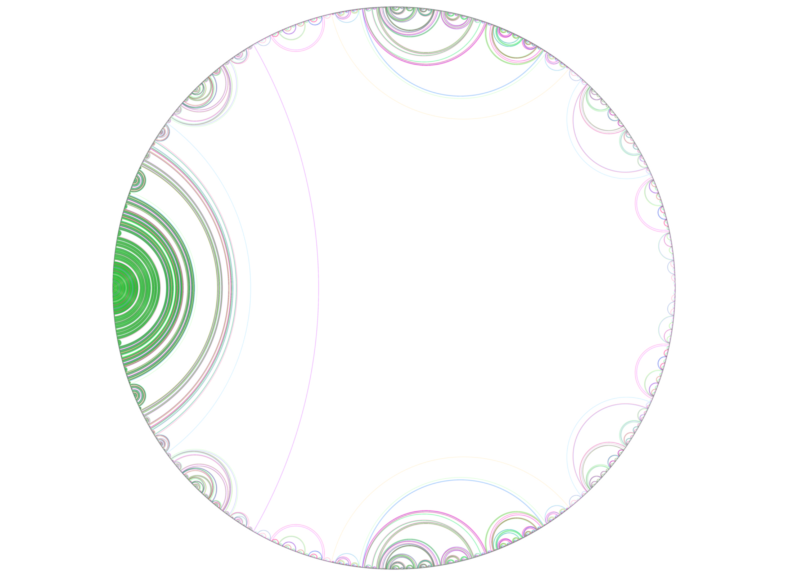Lavaurs' Algorithm

I implemented Lavaurs' Algorithm to render an abstract Mandelbrot Set (in Haskell with SVG output via dirty string concatenation).
> import Data.Function (on) > import Data.List (findIndex, groupBy) > import Data.Ratio ((%)) > import Numeric (showHex) > import System.Environment (getArgs) > > type N = Integer > type Q = Rational
The doubling map identifies periods with points on the unit circle (as rational numbers where 1 is a full turn):
> double :: Q -> Q > double p > | q >= 1 = q - 1 > | otherwise = q > where q = 2 * p > > period :: Q -> N > period p = > let Just i = (p ==) `findIndex` drop 1 (iterate double p) > in fromIntegral i + 1
Generate an infinite list of rationals sorted by their period:
> denominators :: [(N, N)] > denominators = iterate (\(p, d) -> (p + 1, 2 * d + 1)) (1, 1) > > rationals :: [Q] > rationals = > [ q > | (p, d) <- denominators > , n <- [ 1 .. d - 1 ] > , let q = n % d > , period q == p > ]
The algorithm is implemented with a pair of mutually recursive functions. Initially, 1/3 and 2/3 are connected, then the next remaining rational is connected to the next smallest of the same period such that no lower-period arcs are intersected:
> lavaurs :: [(N, (Q, Q))] > lavaurs = (2, (1%3, 2%3)) : lavaurs' (drop 2 rationals) > > lavaurs' :: [Q] -> [(N, (Q, Q))] > lavaurs' (p : ps) = > let (qs, r : rs) = break (available p) ps > in (period p, (p, r)) : lavaurs' (qs ++ rs) > lavaurs' [] = error "broken invariant" > > available :: Q -> Q -> Bool > available p q = null > . filter (intersects (p, q) . snd) > . takeWhile ((< period p) . fst) > $ lavaurs > > intersects :: (Q, Q) -> (Q, Q) -> Bool > intersects (p, q) (s, t) > | q < s = False > | t < p = False > | p < s && t < q = False > | s < p && q < t = False > | otherwise = True
The rest of the program is uninteresting code to output a pretty SVG image:
> main :: IO () > main = do > [n] <- map read `fmap` getArgs > putStr header > putStr . concatMap g . take n . groupBy ((==) `on` fst) $ lavaurs > putStr footer > where > header = unlines > [ "<?xml version='1.0' encoding='UTF-8'?>" > , "<!DOCTYPE svg PUBLIC '-//W3C//DTD SVG 1.1//EN' 'http://www.w3.org/Graphics/SVG/1.1/DTD/svg11.dtd'>" > , "<svg xmlns='http://www.w3.org/2000/svg' width='4096' height='4096' viewbox='0 0 4096 4096'>" > , "<title>Mandelbrot Set by Lavaurs' Algorithm</title>" > , "<rect x='0' y='0' width='4096' height='4096' stroke='none' fill='white' />" > , "<g stroke-width='1' fill='none'>" > ] > footer = unlines > [ "</g>" > , "<circle cx='2048' cy='2048' r='2000' fill='none' stroke='black' stroke-width='1' />" > , "</svg>" > ] > g npqs = let (n:_, pqs) = unzip npqs > in " <g stroke='" ++ colours !! fromIntegral n ++ "'>\n" ++ concatMap arc pqs ++ " </g>\n" > arc (p, q) = " <path d='M" ++ px ++ "," ++ py ++ "A" ++ r ++ "," ++ r ++ " 0 0 1 " ++ qx ++ "," ++ qy ++ "' />\n" > where > pa = 2 * pi * fromRational p > qa = 2 * pi * fromRational q > r = s $ 2000 * tan ((qa - pa) / 2) > px = s $ 2048 + 2000 * cos pa > py = s $ 2048 - 2000 * sin pa > qx = s $ 2048 + 2000 * cos qa > qy = s $ 2048 - 2000 * sin qa > s :: Double -> String > s = show
With colours spread according to the Golden Angle:
> data RGB = RGB Double Double Double
>
> colours :: [String]
> colours = map (rgbToSVG . hueToRGB) [0, 2 * pi / (phi * phi) ..]
> where
> phi = (sqrt 5 + 1) / 2
> hueToRGB h =
> let s = 1
> v = 1
> hh = h * 3 / pi
> i = floor hh `mod` 6 :: Int
> f = hh - fromIntegral (floor hh :: Int)
> p = v * (1 - s)
> q = v * (1 - s * f)
> t = v * (1 - s * (1 - f))
> in case i of
> 0 -> RGB v t p
> 1 -> RGB q v p
> 2 -> RGB p v t
> 3 -> RGB p q v
> 4 -> RGB t p v
> _ -> RGB v p q
>
> rgbToSVG :: RGB -> String
> rgbToSVG (RGB r g b) =
> let toInt x = let y = floor (256 * x) in 0 `max` y `min` 255 :: Int
> hex2 i = (if i < 16 then ('0':) else id) (showHex i "")
> in '#' : concatMap (hex2 . toInt) [r,g,b]References: